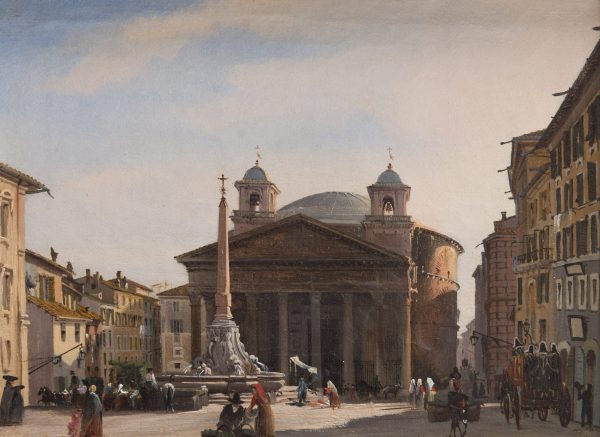The Pantheon, Rome, ca. 1840
Oil on paper laid on canvas, H. 0.23 m; W. 0.3 m
Provenance: Edmondo di Robilant, London, 2004
Private collection, Italy
After a brief period as an apprentice between Belluno and Padova, Ippolito Caffi moved to Venice in 1827 where he undertook his artistic training with more rigore than previously, studying prospective under Tranquillo Orsi (1771-1845). In 1832, Caffi left the city of canals for Rome, where he founded a studio and dedicated himself to the painting of vedute, in which the persistence of a eighteenth-century taste for Canalettian perspective is evident.
By virtue of this intense study of the tradition that had preceded him, Ippolito gained notable success until 1848, when he left Rome to enlist in the war against Austria. The proceeding years were troubled by a period in prison, escape and exile, to which his work responded strongly in terms of subject matter (for example The explosion of a bomb on a lagoon, Museo del Risorgimento, Venice). Having returned to Rome in 1855, Caffi produced some of his most important work, for example Rome seen from the Pincio (Noferi collection, Florence) and The Colosseum illuminated by the Bengal lights (Ca’ Pesaro, Venice). From 1858 Caffi’s status as a patriot became more dangerous still due to the agitated political situation; once again, his paintings attest to this moment of change, with vedute of a socio-political character that depict the advance of Garibaldi and the formation of a united Italy, such as The arrival of Vittorio Emanuele in Naples (Ca’ Pesaro, Venezia) and On the river of the Volturno.
At the outbreak of war against Austria in 1866, Caffi left once again the calm of his Roman studio to follow the events of the military as a war artist. He died in Lissa in July 1866 during the sinking of the “Re d’Italia”, a warship that he had boarded to depict the events of the Third War of Independence.
The present work – a daytime veduta of the Piazza Rotonda with the facade of the Pantheon and the 16th-century fountain by Giacomo della Porta – belongs to the Roman phase of Caffi’s oeuvre, characterized by a vigorous palette and a blurring of the outlines that emancipates his work from the 18th century tradition of vedute, allowing him to achieve greater vibrancy and intensity. While Caffi’s works from other periods are characterized by a clear and serene vision, a closeness to life, and a sensitivity to the effects of light and colour, it is in the Roman subjects repeated on dozens of occasions that the artist succeeds in surpassing the optical approach handed down from Canaletto, executing scenes with great emotive and suggestive power.
In this painting, Caffi selects a classic Roman veduta, widely reproduced since the mid-18th century, changing very little of the Canalettian prototype. The enormous bulk of the Pantheon dominates the centre of the composition, overlapped slightly by the obelisk of the fountain of Piazza della Rotanda and perfectly framed by the facades of the adjacent buildings. Unlike numerous other eighteenth-century vedute, priority is given to the swarm of passers-by, washerwomen and beggars that animate the square, conveying with great immediacy the everyday life of a Roman afternoon. The freshness of this informal scene and the warm luminosity that fills the square is contrasted with the severity of the Eternal City and its monuments, the great mass of the Pantheon ominously shrowded in shadow. Bathed by an oblique light from the West, the vestiges of imperial Rome appear strangely immobile and incumbent; the square is a place of culture, of art and commerical exchange, providing an unperturbed platform around which the events of the day evolve. It is a silent testimony to the life that surrounds it, communicating a sense of the eternity of art and the transience of time.

